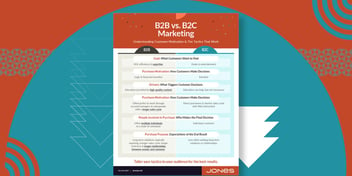Benefits of Content Marketing For Enterprise Software Brands
In a complex industry centered around information and data, it is no wonder that enterprise software marketers find results in content marketing. When buyers are making decisions about solutions that may need to scale to fit the needs of thousands of employees, often in dozens of locations, the decision-making process is methodical and relies on detailed information and trust.
Content marketing fits the bill.
What is content marketing?
Content marketing employs a wide range of content types and channels to provide information and build awareness in the market in ways that improve SEO and provide opportunities for online lead generation. The types of content created and used in a content marketing strategy can range from social media images to thought leadership articles, blog posts, videos, podcasts, whitepapers and reports, and more. Most content marketing today is digital in nature, but the broader umbrella can include traditional print materials as well.
(Wondering how to classify your marketing approach? See the differences in digital vs. content vs. inbound marketing.)
When developing content marketing strategies for any industry, including enterprise software, it is essential to recognize that “content” crosses the traditional marketing/PR divide. Effective content marketing strategies integrate traditional PR tactics and channels with those viewed as more pure marketing channels in ways that create an overarching strategy focused on the same goals. By integrating all tactics and channels under a single strategy, marketers benefit from uniform messaging to all stages of the sales funnel, opportunities to repurpose content and data for multiple channels and greater return on investment in strategies such as original research and surveys
Why should enterprise software brands embrace content marketing?
Enterprise software purchase decisions are information-driven and typically follow long decision cycles.
Content marketing, which is typically centered around in-depth, non-promotional insights and guidance rather than quick-hit in-your-face advertising and promotion, is suited to the needs of B2B technology and software buyers. By providing them with information that can be used directly or indirectly to address the pain points and problems that software can solve for their companies, through awareness level content and PR, marketers earn trust that can carry them into the next stage of decision making when those organizations are actively seeking software solutions.
In today’s environment, especially in the wake of the Covid-19 pandemic, technology buyers (the majority of whom are millennials) want to find information on their own, even up to the point of accessing free trial versions and making purchases without involving a salesperson. Content marketing fits that style of information gathering and decision making well.
5 benefits of using content marketing to reach enterprise software buyers
1. SEO and visibility
Search engine optimization relies on content. Quality website content and blog posts that are designed to provide useful information and insights not only contain the keywords and phrases that your audience is searching for, but also engage your audience to stay on your site longer and visit more pages, important reader signals that also boost search ranking results.
Web traffic is one of the two most-common measurements of success for content marketing strategies, according to HubSpot, and it is a direct indicator of how easy your content is to find.
Business blogs are one of the most effective ways of building up website content for SEO, with additional benefits as well. That is one reason that, according to the Content Marketing Institute, nearly 9 in 10 content marketers use blog posts in their content creation strategy.
2. Brand awareness
With a broad range of content types and channels available, cohesive content marketing campaigns are key in building brand awareness and developing a strong brand position that carries through all of the materials created.
JONES advises all of our clients to think beyond a single channel—not just social media, just a blog, or just thought leadership content—to carry the same messaging out from the top of the funnel through to a closed deal and into customer service after the sale.
The audience should get the same brand message no matter where they encounter the content.
3. Trust and positioning as an industry authority
High quality content that answers questions, solves problems, and seeks to inform as much as sell sets the stage for your brand to be recognized as an industry authority, trusted by customers and prospects alike.
The key to that trust and authority, however, is in the quality of the content. Taking shortcuts and churning out content that has no depth, no originality, and no distinctive authority, such as original research and data, won’t garner the level of respect needed to compete in a highly-technical, data-driven industry like enterprise software.
One proven tactic for building authority and establishing your brand as a leader is to contribute bylined articles to respected industry media outlets.
4. Lead generation
Content marketing is also a key method of lead generation, particularly as generations shift, with the majority of B2B technology buyers now a part of the millennial generation, a group that has always turned to online research before making decisions.
2020 research by TrustRadius shows that millennials and Gen Z are twice as likely as Gen X or Baby Boomers to discover a product by searching online. These decision makers also want more ways of researching on their own before involving a salesperson. But that doesn’t make lead generation any less important, it simply shifts when involvement begins. By using downloadable material such as case studies, worksheets and webinars, along with other offers such as free trials, content can be used to capture leads and continue to nurture them with additional information until they have reached the point at which it makes sense to directly engage.
Carefully analyzing your lead pipeline can help you identify the key indicators of a qualified lead, and then pass that lead on to sales with in-depth lead intelligence so that your sales team avoids the things most likely to turn off technology buyers: cold calling, aggressive sales representatives, uninformed sales pitches and non-personalized communications.
5. Cost-effective performance that keeps delivering
The initial upfront cost of content development may seem steep, as marketers are shifting as much as 30 percent of their marketing budgets to content. But the benefits are long-lasting, and that cost can be spread over multiple content pieces if you plan well and repurpose material across multiple content formats, channels and stages of the buyers’ journey.
HubSpot identified 10 years ago that the cost of leads generated through inbound content marketing was 62 percent less than the cost of outbound marketing-generated leads. That advantage has not diminished. If anything, content’s staying power in contributing to the 4 benefits listed above accentuates the cost-effectiveness. Blog posts from months and years in the past continue to drive SEO performance and generate leads, long after paid advertising and email blasts have faded into memory.
A single survey or research project to develop content marketing material can be used to create up to 100 different pieces of content deployed across multiple channels.
In an industry driven by large amounts of information, sensitive data, and decision-makers who may be more comfortable behind a keyboard than across the boardroom table from a sales representative, content marketing just makes sense. But to be effective, that content has to be high-quality, useful, and focused on answering the key questions and pain points of the B2B enterprise software purchasers. Learn more about the JONES experience in this field here, then download our Content Creation Solution to learn about our philosophy for ensuring that all content created for our clients is on target to achieve the results needed.
If you’d like to chat about how JONES can supplement and support your marketing team in developing comprehensive content marketing strategies and campaigns, let’s chat. You can schedule a time in my calendar for a no-obligation consultation.
-1.png?width=1652&height=294&name=Jones(RGB)-1.png)












